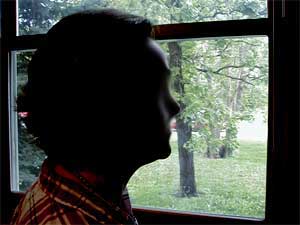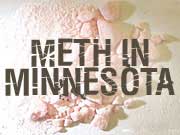Meth is not just a rural problem anymore
June 14, 2004
 |
| "Susan," 38, a stay-at-home mom from Minneapolis, checked into a halfway house in April to recover from a 20-year meth habit. She says the meth problem in the Twin Cities is "probably greater than crack," but harder to spot. This photo has been adjusted to protect her identity. (MPR Photo/Jeff Horwich) |
St. Paul, Minn. — Think about the images, the news stories you've seen about meth in this state. Imagine the tubes and vats among the broken furniture and filth of a run-down shack in the country. Think of the haggard, sleepless meth cook dumping hazardous waste down the kitchen sink.
Then, think again.
Sure, these places exist -- state officials found more than 400 mini-meth labs last year. But they are not the heart of the Minnesota meth supply. The Twin Cities is. Think of it as a meth "depot." Eighty percent of our meth comes from out of state, smuggled in delivery trucks and hollowed-out car bumpers. After changing hands here, much of it leaves again -- for the suburbs, Indian reservations, and small towns where meth ruins lives.
|
This is a trans-shipment point in the upper Midwest. ... Some of it is headed for Chicago, areas out east, some of it is actually headed for Canada. So they definitely see this as not only a place for end users, but as a transit point.
- Tim Counts, U.S. Immigration and Customs Enforcement |
"Our agents say that this is a trans-shipment point in the upper Midwest," says Tim Counts, a spokesman for U.S. Immigration and Customs Enforcement, one of many law enforcement agencies trying to choke off the meth pipeline to the Twin Cities. "Some of it is headed for Chicago, areas out east, they think. Some of it is actually headed for Canada. So they definitely see this as not only a place for end-users, but as a transit point."
One particular map of the U.S. -- normally available only to law enforcement -- is a good illustration. It shows two major meth-trafficking bands stretching across the country. A yellow band rises up from Mexico, through Texas and the grain belt. A pink one reaches from southern California, northeast through Colorado. Pink and yellow meet in the Twin Cities.
"I think it would be unrealistic to say law enforcement has an idea of how much is coming in. We certainly don't intercept the majority of it," says Sgt. Jeff Miller, who works on the narcotics unit of the Minneapolis police.
He says, if anything, the era of the isolated, rural meth lab is waning. The health hazards are too great, and the risk of capture is rising. "Superlabs" in the southwest and Mexico can churn out 10 pounds of meth in a day, compared with the few grams painstakingly produced in a mini-lab.
Miller says this mass-produced meth that arrives in the Twin Cities is cheap. That doesn't mean the street prices are falling -- addicts, after all, are willing to pay what it takes. What it does mean is big money for a thriving network of middlemen.
"There are huge profits to be made," Miller says. "At most steps the methamphetamine can be reduced in purity, or 'cut,' as we say, and you can essentially double your money."
Anything from powdered vitamin C to scouring powder or fiberglass can invisibly dilute snortable, powdered methamphetamine. Some middlemen cook the powder into crystals, the smokeable form of meth.
Then the distribution networks kick in -- essentially, the dealers for the dealers.
 | |||
"The shipment is broken up into a number of smaller shipments, and these are turned over to -- they could be black street gangs, it could be white motorcycle gangs, it could be independent entrepreneurs who are out doing this business," Miller says.
In November 2003, the head of the Minnesota Hell's Angels began a 17-year federal prison sentence. Investigators say Patrick Matter ran a meth distribution ring out of his north Minneapolis motorcycle shop. Miller says another investigation, still unfolding, has netted a dozen people this spring. They include the Mexican nationals who brought the drugs here.
The trail has also led to a Minneapolis bar, some associates in St. Paul, and a location in Forest Lake, a suburb to the north, where 40 pounds of meth were recovered.
An occasional big bust like this doesn't mean Miller is encouraged. Budget cuts have brought the Minneapolis narcotics unit from 16 officers in 2001 to 11 today. Their meth seizures were down 70 percent last year, even as meth activity is on the rise. And the unit has other things on its plate -- namely cocaine and crack cocaine, where street-dealing and guns can create their own, more pressing problems.
To a narcotics officer, the Twin Cities meth scene is mostly about the business, the trade, the supply feeding the rest of the state. This can overshadow the fact that meth addiction affects thousands of lives here. In 2003, more than 1,700 residents of the seven-county metro area received treatment for meth -- 44 percent of all meth cases statewide.
"Susan" is one metro resident finally receiving treatment, after a 20-year addiction.
"Back then they called it crank," she says. "I used to just snort it back then. But I'd say within about the last three years on and off, I've been mixed in with the really high grade, the 'fluff.'"
Susan, 38, is a stay-at-home mom in Minneapolis. Or she was, until child protection took her three children and charged her with endangerment. In April, she checked into a halfway house for treatment. Susan chose not to use her real name -- she says meth makes people paranoid and dangerous, and its better her former associates don't know she's telling her story.
 | |||
Because she and her now-ex-husband spent so much of their money -- and money from her parents -- on the drug, they had the "water being turned off, our house practically going into foreclosure. And my children, as much as I hid it from them, they noticed differences," Susan says. "I'd be up really late at night. They'd get up in the middle of the night to go to the bathroom and I'd still be up doing stuff."
In the past year, Susan and her ex began cooking their own meth with friends. One chore involved buying or shoplifting the ingredients -- drain cleaner, Sudafed and fertilizer -- from local stores.
They went to "Menards or hardware stores for some of it. The pseudoephedrine (came) just from, like, Walgreens or Rainbow," Susan says. "You couldn't get your whole supply in one place. You had to hit a couple Walgreens or a couple Rainbows just so you wouldn't draw attention to yourself."
Susan says she took care of herself, using the drug in moderation and forcing herself to eat -- an oversight that leaves some meth addicts looking emaciated. She says many addicts in the Twin Cities are like her -- hard to spot.
"I think it's harder to distinguish because some people just seem like they're high energy," she says. "They don't exhibit the typical signs of meth use -- anorexic-looking, bad teeth, that type of thing. Some people are able to function to the outside world as regular people."
Susan is white. So were more than 90 percent of those who got meth treatment in the Twin Cities last year. But the drug's appeal is growing. More than 3 percent of those who received treatment were Hispanic. Carlos Morales, at the Minnesota Institute of Public Health, says the drug is in its early stages in that community, but the danger is growing.
"Even though the trafficking is coming from Mexico, it doesn't necessarily mean the Hispanic community is using it," Morales says. "I think right now they are starting to explore a little bit of it. They're starting to discover what the effects are of this drug."
Morales says Spanish-language literature about meth is minimal, a situation he would like to change.
Janice Lindstrom is the executive director of Juel Fairbanks Chemical Dependency Services in St. Paul. The drug treatment center often takes referrals from Minnesota's American Indian communities. She says many Indians go back and forth frequently between the Twin Cities and their reservations, and meth sometimes travels with them.
"They make it up north and it comes down here, or they may make it down here and it goes up to the reservations," Lindstrom says. "The reservations are having a terrible time with chemicals right now, and they're coming from here. They're coming from the Cities and going up."
Earlier this year, Warmeng Moua profiled young crystal meth addicts in his St. Paul-based newspaper "Hmong Today." He says the drug has its own slang within the community.
"They would call it 'pob-zev,' which means 'rock,' 'khlonoom,' which means candy, or 'cov zoo,' which is 'the good stuff,'" Moua says.
He says young people use meth to stay up and party through the night. Hmong girls use it to lose weight, while street gangs deal it to make money.
Moua says meth is a common thread in recent crimes that have put the community in the news.
"One of the reasons we started looking into this is that you would read (in the newspapers), 'Hmong pimps with adolescent girls.' We looked further into it and found out that in almost about every case of prostitution in the Hmong community, crystal meth is the drug that they lured these girls into it with."
Moua says the Hmong community reaction to the newspaper story has been harsh -- many are not comfortable having this "dirty laundry" out in the open.
"I definitely think the community has to look at it and say, 'I've got a niece who's on it, I've got a brother who's on it, I've got a cousin, my daughter, who's on it, I need help,'" Moua says. "I don't think they understand how powerful that drug is, how destructive it actually is."
The Hmong are another example of the meth reality that plays against stereotype -- new ethnic communities being affected, a lot of urban meth addicts, the Twin Cities pipeline of cheap Mexican stuff that actually feeds the Minnesota habit.
That's not the meth we thought we knew.
|
News Headlines
|
Related Subjects
|

